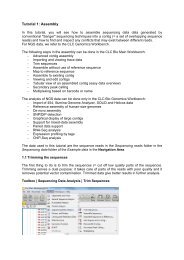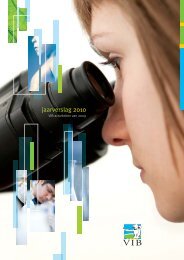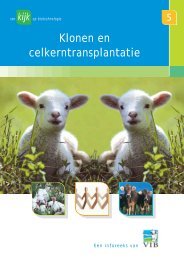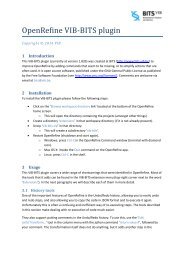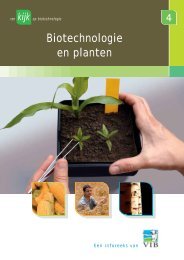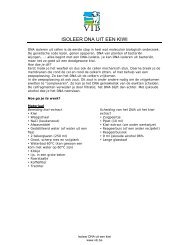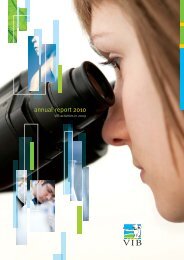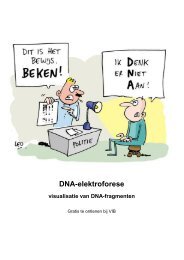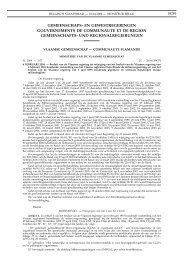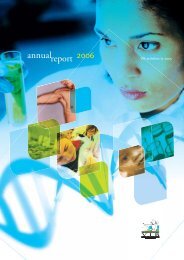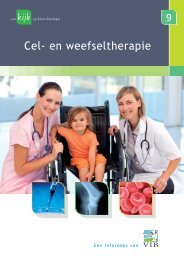Biosafety in the laboratory - VIB
Biosafety in the laboratory - VIB
Biosafety in the laboratory - VIB
Create successful ePaper yourself
Turn your PDF publications into a flip-book with our unique Google optimized e-Paper software.
CHAPTER C.<br />
GUIDELINES FOR THE CLASSIFICATION OF ACTIVITIES IN ANIMAL<br />
HOUSES INVOLVING TRANSGENIC ANIMALS OR ANIMALS THAT<br />
CARRY GENETICALLY MODIFIED MICRO-ORGANISMS OR CELLS<br />
Conta<strong>in</strong>ment level A1:<br />
• The animals that cannot spread easily <strong>the</strong>mselves (pigs, sheep, cattle) and that have taken up a transgene<br />
<strong>in</strong> <strong>the</strong>ir genome without <strong>the</strong> help of a viral vector.<br />
• The animals that cannot spread easily <strong>the</strong>mselves and that carry a risk class 1 GMO.<br />
Conta<strong>in</strong>ment level A2:<br />
• The animals that are able to spread easily <strong>the</strong>mselves (small rodents, rabbits, <strong>in</strong>sects, fish) and that<br />
have taken up a transgene <strong>in</strong> <strong>the</strong>ir genome without <strong>the</strong> help of a viral vector.<br />
• The animals that are able to spread <strong>the</strong>mselves and that carry a risk class 1 or 2 GMO.<br />
Notes<br />
The classification of animals that carry genetically modified micro-organisms or cells is more complex<br />
than <strong>the</strong> classification of <strong>the</strong> genetically modified micro-organisms or cells as such. This is because with<br />
such activities not only <strong>the</strong> risk class of <strong>the</strong> modified micro-organism is important, but also <strong>the</strong> comb<strong>in</strong>ation<br />
animal/micro-organism, <strong>the</strong> way <strong>the</strong> micro-organism is adm<strong>in</strong>istered, and <strong>the</strong> possibilities of <strong>the</strong><br />
micro-organism to spread from <strong>the</strong> animal to <strong>the</strong> environment. In a normal <strong>laboratory</strong> <strong>the</strong> micro-organism<br />
is kept <strong>in</strong> a closed conta<strong>in</strong>er, and if this conta<strong>in</strong>er is opened and <strong>the</strong>re is a risk of spread to <strong>the</strong><br />
environment, <strong>the</strong>n <strong>in</strong> many cases <strong>the</strong> conta<strong>in</strong>er will only be opened <strong>in</strong> a safety cab<strong>in</strong>et (class 2 and higher).<br />
The <strong>laboratory</strong> animal cannot be considered a closed conta<strong>in</strong>er. This is why for every specific comb<strong>in</strong>ation<br />
of <strong>laboratory</strong> animal/micro-organism it has to be determ<strong>in</strong>ed whe<strong>the</strong>r <strong>the</strong>re is a need for additional<br />
measures to prevent escape of <strong>the</strong> micro-organism to <strong>the</strong> environment. In annex 1, under conta<strong>in</strong>ment<br />
levels A1 to A4 <strong>the</strong>se additional measures have been described under: “recommended” or<br />
“optional”.<br />
An example: a risk class 2 genetically modified adenovirus should be handled <strong>in</strong> a <strong>laboratory</strong> us<strong>in</strong>g L2<br />
conta<strong>in</strong>ment measures. When such a virus is vaporised as an aerosol <strong>in</strong>to <strong>the</strong> lungs of a mouse, basic A2<br />
conta<strong>in</strong>ment measures will not be enough to prevent <strong>the</strong> unwanted spread of <strong>the</strong> virus. The mouse will<br />
have to be kept <strong>in</strong> special cages fitted with a filtertop, and all <strong>the</strong> waste (faeces, ur<strong>in</strong>e, bedd<strong>in</strong>g material,<br />
etc.) will have to be <strong>in</strong>activated. If <strong>the</strong> same experiment would be done <strong>in</strong> a pig, <strong>the</strong>n aga<strong>in</strong> additional<br />
measures would be necessary, but measures that are different than <strong>in</strong> <strong>the</strong> case of <strong>the</strong> mouse. It will not<br />
be possible to keep <strong>the</strong> pig <strong>in</strong> a filtertop cage. The stable as a whole will have to provide <strong>the</strong> proper conta<strong>in</strong>ment.<br />
This means that <strong>the</strong>re will have to be an airlock, negative airpressure, fumigation will have to<br />
be possible, personnel will have to wear special protective cloth<strong>in</strong>g that will rema<strong>in</strong> <strong>in</strong> <strong>the</strong> airlock when<br />
leav<strong>in</strong>g <strong>the</strong> stable, and <strong>the</strong>re will have to be special equipment for <strong>the</strong> collection and <strong>in</strong>activation of faeces<br />
and ur<strong>in</strong>e (a closed collection system connected to a <strong>in</strong>activation tank).<br />
Guidel<strong>in</strong>es for <strong>the</strong> classification of GMO-activities 63



